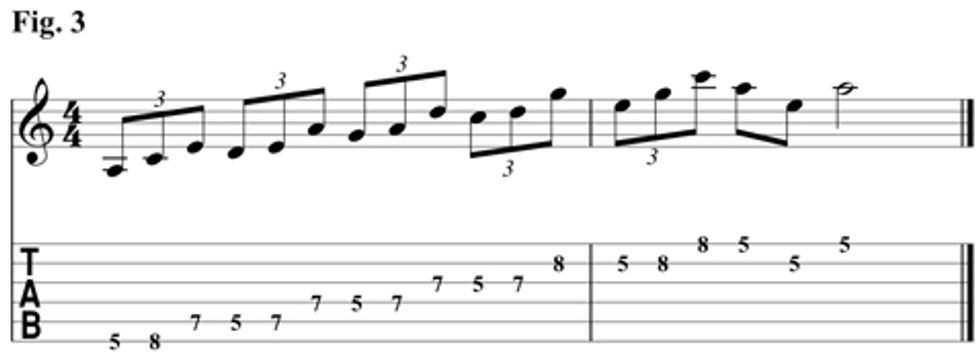This month we’re going to take a look at how to roll the fingers across the strings.
Theory: Beginner
Lesson Overview:
• Use a “rolling” technique to make your single-note lines smoother.
• Create interesting intervallic lines based on pentatonic shapes.
• Superimpose six-note patterns over a 4/4 time signature.
Click here to download a PDF of this lesson's notation and audio examples.
This month we’re going to take a look at how to roll the fingers across the strings. I don’t hear this technique too much from blues players, but it will open up a lot of new sonic possibilities.
We begin with Fig. 1, which is a simple A minor pentatonic scale (A–C–D–E–G) based on a series of descending fifths. This means that we move down a fifth starting on each note of the scale. Because the guitar is tuned in fourths (the inversion of a fifth), many of the notes line up on the same fret. As you move from one string to the next, try to set your fingertips a little lower on the higher string so the fingertip can roll to the lower string and still be on the same finger, just a little higher on the tip. This will take some work at first, but will be well worth the effort.
For Fig. 2, we take the same idea and move it down the neck to the next position of the A minor pentatonic scale. Make sure to spend time working out each of the five pentatonic fingerings with a metronome.
In Fig. 3, we change the direction and rhythm to create a new sequence. We are still sticking with A minor pentatonic, but we ascend using a three-note triplet pattern that begins with every other note of the scale. You end up with a combination of seconds, thirds, and fourths before ending on the root (A) on the 1st string.
The tempo increases slightly with Fig. 4. Here we use a six-note pattern over a 4/4 rhythm, which creates an uneven feel when you factor in the use of the hammer-ons. This sound is probably most associated with the Allman Brothers. Play this lick slowly at first and then increase the metronome settings as you get more comfortable.
Fig. 5 is a descending lick that uses the lowered 5 as well as a slippery sliding kind of sound. This cool phrase uses the rolling technique as well, and produces a very legato sound that will take some time to achieve. Once again, you’ll want to take this slowly at first.
I hope you have enjoyed adding this new technique to your arsenal. You might hear this sound when listening to players like Oz Noy or Scott Henderson. They are two very different guitarists who take their blues playing very seriously.
 Dennis McCumber has been a guitar instructor and performer
for more than 20 years. He holds a Bachelor’s degree in music
education from The College of Saint Rose.
Dennis performs
regularly in the New York City area with various rock, blues, and funk bands, and occasionally as a classical soloist.
In addition to performing, Dennis has been a middle school
music teacher in the Bronx for the past 12 years. While
teaching in the Bronx, he was given a guitar lab by VH1
Save the Music and a keyboard lab from the radio station
Hot97 Hip Hop Symphony. Dennis has been an instructor at
the National Guitar Workshop since 1996, where he teaches
Blues, Funk, and Rock. Find out more at dennismccumber.com.
Dennis McCumber has been a guitar instructor and performer
for more than 20 years. He holds a Bachelor’s degree in music
education from The College of Saint Rose.
Dennis performs
regularly in the New York City area with various rock, blues, and funk bands, and occasionally as a classical soloist.
In addition to performing, Dennis has been a middle school
music teacher in the Bronx for the past 12 years. While
teaching in the Bronx, he was given a guitar lab by VH1
Save the Music and a keyboard lab from the radio station
Hot97 Hip Hop Symphony. Dennis has been an instructor at
the National Guitar Workshop since 1996, where he teaches
Blues, Funk, and Rock. Find out more at dennismccumber.com.





